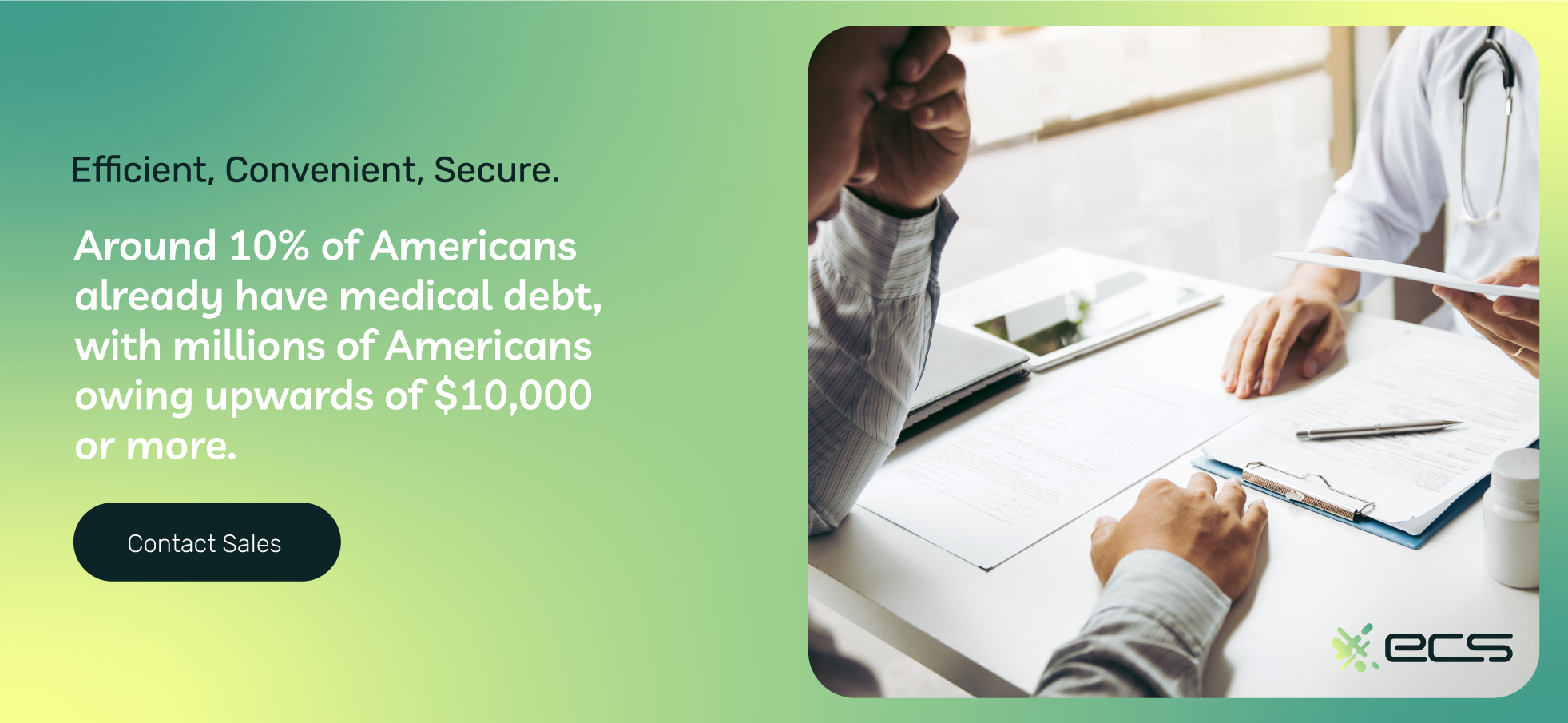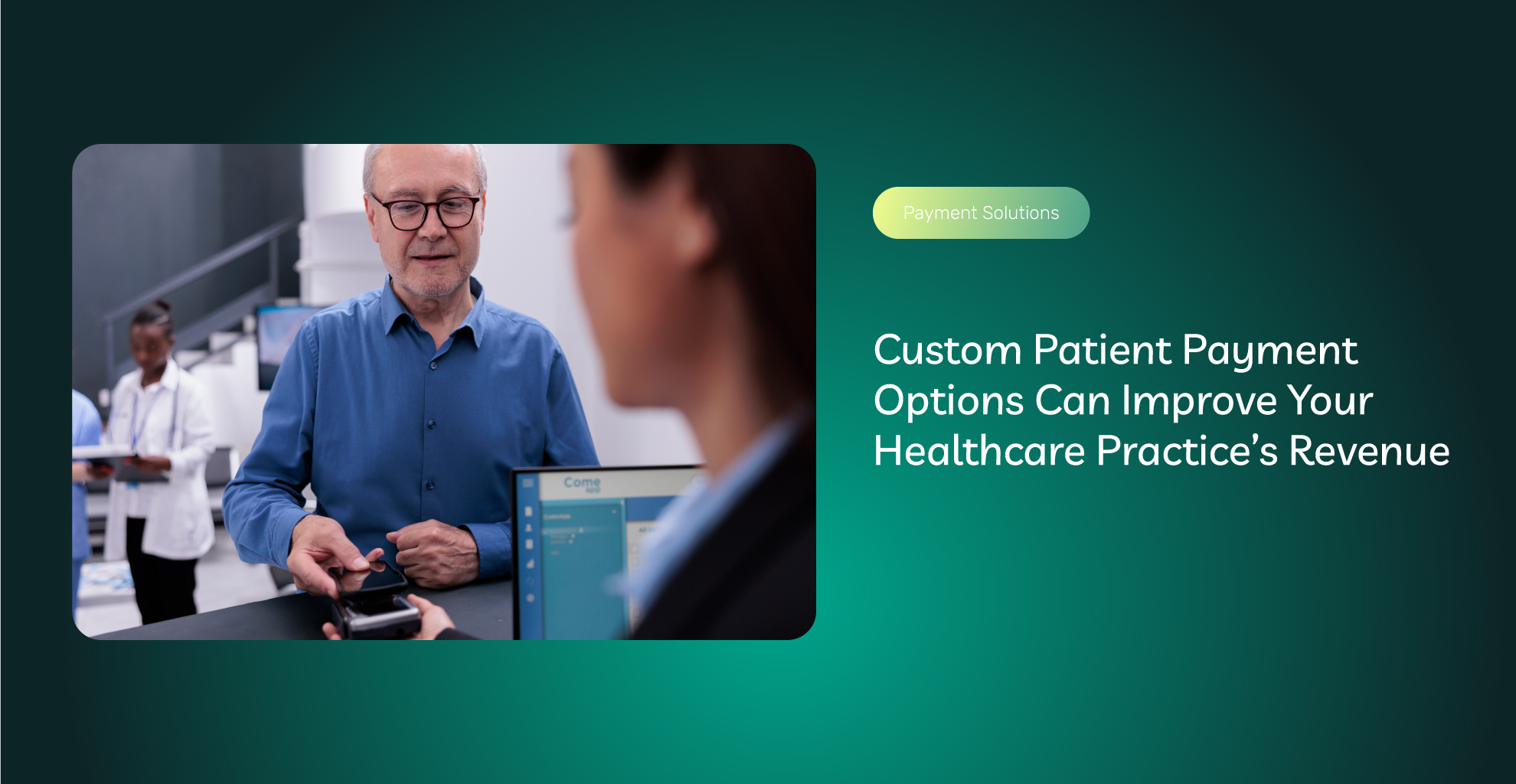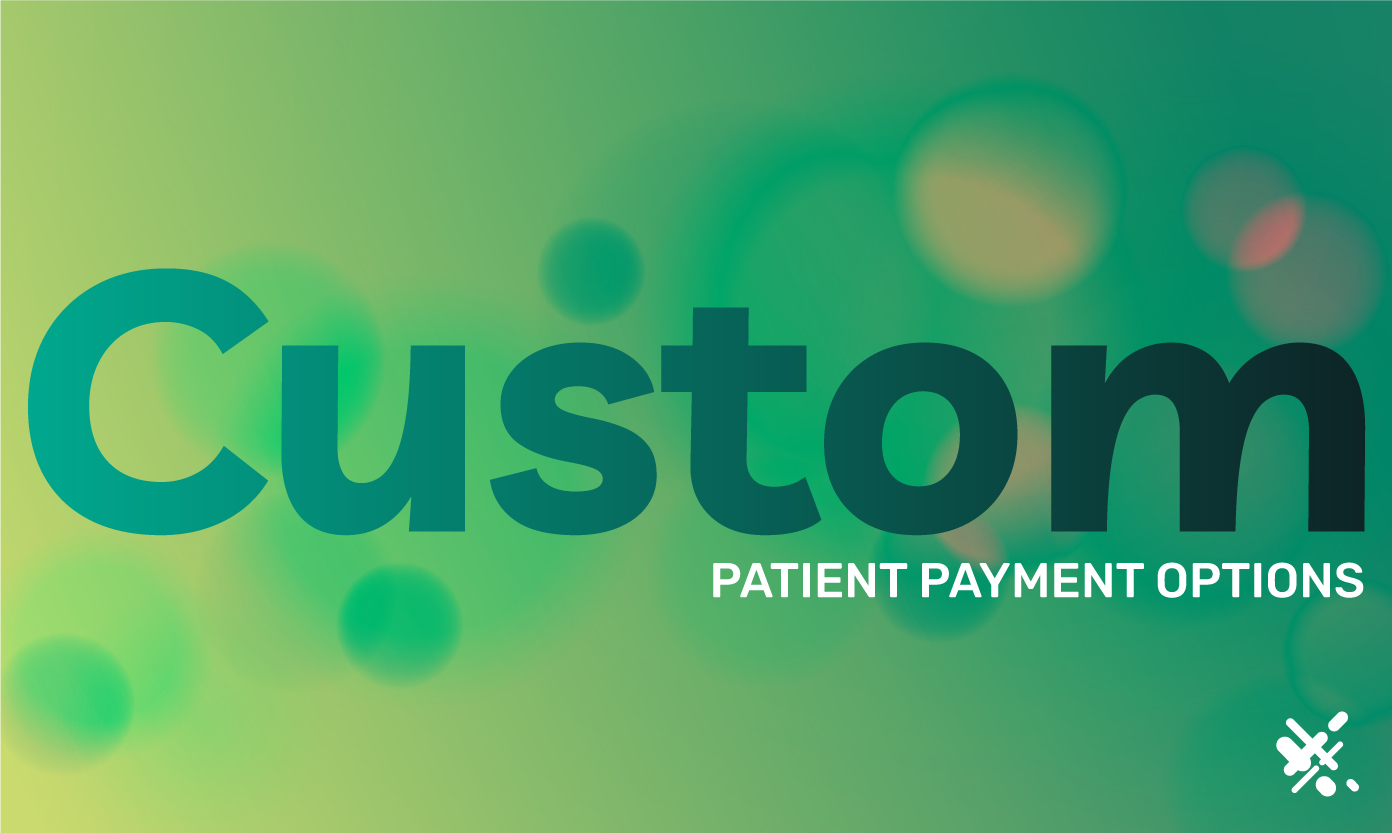Custom Patient Payment Options Can Improve Your Healthcare Practice’s Revenue
It’s no secret that the healthcare system has extraordinary amounts of “bad debt,” which often stems from uncollected patient payments. Let’s remember that patients are also consumers, and these consumers already have other forms of debt.
Because there is so much legislation around medical expenses, patients may feel that they can put off paying a doctor’s bill or hospital bill in favor of a credit card, mortgage, or student loan repayment.
This is not a good prognosis for healthcare practitioners from a business perspective. Increasing amounts of bad debt can eat into revenue and surpass their usefulness as a tax write-off. But thankfully, there is a way to make everyone happy—the patient and the practitioner—with flexible payment arrangements.
What Are Custom Patient Payment Options All About?
Customized patient payment options are all about splitting a larger payment into more digestible parts. This will allow patients who cannot pay all at once to get the care they need. And since they see that they can enroll in a manageable payment plan, it can also increase your practice revenue. Lastly, payment plans can eliminate bad debt, which also increases practice revenue.
How Do Patients Feel About Their Medical Bills?
First, a little more about patients. Medical debt is an increasing problem in our country, and patients are actually getting angry about it. Only 15% of patients with healthcare debt feel that their providers have their best interests in mind.
This tells you that the other 85% believe their providers are in it for the money. This can be disheartening for caregivers to read because, more likely than not, they’re in it for the altruism of providing care.
Granted, surprise bills, like a visit to the emergency room, generate much of this irate patient-consumer sentiment. In fact, the cost of an emergency room visit, X-rays, and a brief 5-minute consultation before discharge often shocks patients.
Out-of-pocket Expenses and Skipping Care
This is a much different situation than patients faced with the option of receiving care. However, the picture here is not much less bleak. A recent Gallup poll revealed that 38% of Americans in 2022 skipped out on some form of care because they were concerned about the cost. This is up from 26% just one year earlier, a huge 12-point jump.
Moreover, insurance does not necessarily fix the situation. Around 33% of subscribers are already concerned about paying their monthly premium, and 44% worry about affording their deductible before insurance comes into play. More and more Americans have high-deductible plans, which means more copays and out-of-pocket expenses.
The average American is paying $1,763 in out-of-pocket medical expenses, which is significantly up from around $1,300 just a few years ago. As mentioned, one contributing factor is the high-deductible plan. These plans offer lower premiums, which makes them more appealing to patients living paycheck to paycheck.

The Debt Mountain
Here are a few more brushstrokes to complete the portrait of medical debt in America. An average three-day hospital stay can cost up to $30,000 or more, which is enough to medically bankrupt most patients.
Around 10% of Americans already have medical debt, with millions of Americans owing upwards of $10,000 or more. Out-of-pocket healthcare costs are rising more than 10% year-over-year and, in select states, eat away about 15% of residents’ incomes.
Almost 60% of polled adults think they will be able to pay off their debt within two years, while around 33% think that they’ll get it paid off in one year. Unfortunately, around 18% do not think they’ll ever be able to pay off their medical debt.
The picture becomes more nuanced based on the amount of debt. Of those who owe less than $1,000, 63% believe they can pay it off within one year. But of those who owe more than $10,000, 53% think they will never pay it off.
The Impact of Inflation on Patient Payments
Inflation is only making this situation worse. Consumer index prices have risen dramatically over the last few years, sending the price of staples and everyday commodities soaring. While these numbers have cooled recently, the impact has done its damage. Families may be spending $709 more per month than they did two years ago, which comes out to $8,508 per year.
Consumers are taking items out of their shopping carts and having to decide between gas or dinner out (gas or groceries in some instances). These financial difficulties are pushing more and more consumers into high-deductible plans as they struggle month to month.
As a result, when there is a need for unforeseen medical care, the expenses increase. On a monthly basis, their insurance premiums seem more tenable, but once medical surprises inevitably roll around, there is a price to pay. Of course, that begs one to wonder if patients can skirt medical care in favor of saving money—because, as mentioned, nearly 40% of them do.
The State of Health in America
Unfortunately, it does not seem like patients can skirt medical care forever. Excess mortality rates have increased in the U.S. after the COVID-19 pandemic. These rates indicate a propensity for health problems, both physical and mental.
About 10% of the country has diabetes, and 20% of those people don’t know they have it. Moreover, a whopping 80% of the country is pre-diabetic. More than 18 million Americans have heart disease, which is the number one killer. And a stunning 122 million Americans over the age of 20 suffer from hypertension or high blood pressure.
We are here to discuss how payment plans can improve your patient experience—not to conjecture about the causes of America’s rampant health problems (although one wonders if it could be the 200,000+ fast food restaurants that do the American landscape). We bring all this information together to emphasize that patient-consumers face significant medical expenses over their lifetime, leading to financial strain.
Uninsured Patients and Elective Procedures
Then, there are some patients who are totally uninsured anyway. Around 8% of the country, or 27 million Americans, do not have health insurance at all. This rate dropped 18% during the pandemic (although insured patients will still have copays, as discussed above). However, this is still a significant number.
Some of these individuals exist in the twilight zone of not qualifying for Medicaid but lacking the means to afford their own plans. Others are ideologically or religiously opposed to third-party healthcare payers such as insurance. And some just don’t want it.
Some individuals, however, seek some kind of elective surgery that their insurance company does not cover. Plastic surgery is one example, as are alternative paths such as Traditional Chinese Medicine. Then there are specialty surgeries such as devices that reduce snoring or hydraulic devices that can…well, never mind.
These types of patients are also going to be making out-of-pocket payments. But these are unlike patients surprised by a $1,000 emergency room visit or those facing a dentist visit (sorry dentists, but you are the most commonly skipped form of care in the face of financial strain). These patients know what they are getting into. They have determined that these elective surgeries will improve their quality of life and are willing to make the payment.

How Is Bad Debt Impacting Providers?
To return to those patients who are unable to pay, let’s discuss you, the provider. Unpaid debts also have an impact on the healthcare system. Bad debt is an outstanding trend in healthcare payments. As a result, there is an entire accounting system in place for writing off bad debt.
If providers do not set up accounting practices around bad debt, they will lose the potential revenue entirely. However, if they can write it off, they can at least reduce their tax burden. Still, these accounting practices are also burdensome. But, a busy practitioner certainly cannot handle these. A practitioner will be lucky to find a small business accountant who is adept at handling them, too.
Larger providers like hospital systems have the resources in place to determine which bad debt they will write off as charity and which bad debt they will lump into small balances. Perhaps this is one reason why so many hospitals are able to stay afloat while carrying hundreds of millions of dollars in bad debt. In any other industry, these types of numbers would crash the stock value and force the company into bankruptcy.
The average mean bad debt among 4,500 American hospitals is $11.5 million, while the median average is $4.3. The average mean bad debt ratio compared to revenue is 46.6%, while the median is 15.7%. As mentioned, these types of numbers would shut the average small business down, including your private practice.
The truth is that patients are willing to pay. However, they may postpone their medical bills in favor of mortgage payments. After all, if they don’t pay their mortgage, the bank will take their home. If they don’t pay their hospital bill, the hospital will keep sending them letters. It’s not about intention but about resources.
To reduce bad debt and make it possible for strapped consumers to meet their financial obligations, you must consider new patient payment solutions. You provided them with the care they needed. Societal rules (and, indeed, the law) seem to dictate that they have a responsibility to defray the costs you have incurred. That’s where convenient payments come into play.
Buy Now, Pay Later Patient Payment Options
To introduce improving the payment experience for your patients and how it can help increase your revenue, let’s turn to a different industry: retail. Remember that two issues impacting your revenue are (1) customers (patients), the inability to pay large, lump-sum amounts, and (2) the amount of bad debt you have in the wake of treatment.
One trending payment method, especially online, is BNPL or Buy Now Pay Later. Companies like Klarna, Affirm, and Afterpay have formed partnerships with larger retailers like Amazon, Walmart, and Target. These partnerships allow consumers to shop for things they would like but split the payment into smaller sizes.
This is much different than using a credit card. For starters, there is no interest added to the payment, at least on the customer end. The fintech company facilitating the BNPL will charge the merchant something like 6% for the privilege of offering BNPL.
Is it worth it for merchants to offer BNPL, given the fact that these fees are twice what it costs to accept a regular debit or credit card payment? One study conducted by RBC shows that merchants who offer BNPL see a 20-30% increase in sales and a 30-50% increase in revenue. So there you have it…more sales and larger sales, which certainly means more revenue.
Point of Sale Financing in Healthcare Settings
Retail commonly uses BNPL, while other industries utilize the term point-of-sale financing, such as in a service-based business (like your practice).
This type of arrangement seems very similar to CareCredit, which many providers are familiar with. CareCredit is different in that CareCredit is actually a credit card. There is a wonderful introductory period of 0% interest, in which the patient will presumably pay off their medical debt. Unfortunately, if they don’t, they will have to pay all the “back interest” they would have owed originally.
Of course, another issue is that in order to get a credit card, patients need good or at least decent credit. Point of Sale Financing is not a credit card. There is no interest to speak of and often no involvement with the patient’s credit. As long as the patient does not have a fraud alert and they’re not on a terrorist watch list, it is very likely they will receive approval.
The fintech company partnering with the processor will pay you, the provider, in a lump sum. Usually, this occurs within 48-72 hours. The provider (you) will not have to collect anything from the patient.
Rather, the patient will be responsible for making payments to the lender. In many cases, the patient will be able to select a payment plan that works for them. Plans will vary, but as an example, they could pick between paying it off in 6 months, 12 months, or 24 months.
Example of A Third Party Installment Plan At Work
Let’s say you are a provider with a patient who needs a procedure that their insurance does not cover. You agree to meet with the patient for a consultation to discuss the details of the procedure in your office.
If the patient agrees to the procedure, you can present them with a mobile POS terminal right in your office (for instance, your phone or their phone, accessing a payment gateway). The patient will input a few pieces of information, such as name, address, and contact info. The patient will undergo a brief background check for fraud alerts and terrorist watch lists (as mentioned earlier).
Assuming you are not dealing with Osama Bin Laden, the patient will likely receive approval. Whether or not Osama actually received dialysis in American hospitals abroad or even on U.S. soil, we’ll leave it for you to discuss around the Thanksgiving table.
You can perform the procedure the same day or at a later day, which is up to your schedule and discretion. The beauty of building the sale into the consultation is that you will make sure the patient qualifies for the installment plan.
Suppose they do, all good. If they don’t, you will have some decision-making to do. Will you turn the patient away (something that is easier to do, at least in terms of conscience, if it’s an elective procedure), or will you go to your backup plan?
Setting Up Your Own Patient Payment Installment Plan
The next best option here is to customize the payment options yourself. You will not be able to receive a lump sum for the treatment or care upfront. However, you will be able to set up a payment plan with the patient. You can also do this pre-care so you can lock in those payment details.
There are a number of ways to go about this. The best way is creating a payment plan that is automated. Your payment processing company, such as ECS Payments, can help with this. The patient can provide financial information such as a card number or banking information for an ACH transaction.
You can include specifications in an agreement that stipulates that you will withdraw a certain amount of money from their account or charge their card on a set day every month.

Go With ACH Transactions For Patient Payments When You Can
As a side note, bank account information is often better in this regard. After a user loses their card or has reported theft, the replacement card will have new information. Card payments may also not go through if the payment processor finds out there are insufficient funds in the account. However, ACH payments (that is, payments drawn right from the checking account) are different.
For starters, they will often still go through even if the patient has insufficient funds at that time. The patient will have that business day to put funds into the account to rectify the balance. Although you don’t want them to be in that situation, it can be one way to increase the likelihood of collecting payment on time.
Another reason is that bank account numbers do not change, ever. While debit cards can get lost, stolen, or canceled, banking info is forever (unless they close the account, of course). This makes the consistency of your payments much more likely.
A final reason is that ACH transactions cost a lot less than card transactions. ACH transactions usually cost less than three dimes per transaction, while card transactions may cost 2-3%. While this difference is negligible for smaller purchases, for larger purchases like medical care, it is noteworthy.
How Do Recurring Payments Work?
Storing patient financial information is subject to all sorts of rules imposed by Visa, Mastercard, and the HIPAA Act. It is hard to adhere to all these rules yourself. That said, it’s easiest to let a payment processor manage all the storage for you. You will not have to keep any card numbers or bank account numbers on file. Secure data clouds will store it all remotely.
All you need to do is set up the payment plan with your patient. Rectangle Health partnered with ECS Payments (as one example) can help you automate payments and set up automatic reminders (text or email). These automated, recurring payments are an excellent way to eliminate lost revenue due to negligence or forgetfulness.
Much like the BNPL installments, you will be able to build some flexibility into the repayment plan. In fact, there may be even more flexibility than the POS medical financing because you are setting the parameters. If your patient needs 24, 36, or 48 different payments to pay off their bill, you can set that up and automate it.
You will want to give your patient some sort of sales receipt or proof of payment. You can present this along with any health plans you give them for after-care. This payment receipt can spell out the terms of the payment plan, such as the date and amount of recurring payments.
Custom Patient Payment Options Wrap-Up
The custom payment options we’ve discussed need more than a handshake and a paper bill sent every month (to be sure, these types of arrangements contribute to bad debt). Rather, they need a payment platform that is integrated with invoicing software, your medical records, and insurance billing suites (for copays in particular).
This type of specific solution is best provided by a company that is familiar with the healthcare industry. Rectangle Health is one such company. Leveraging the help of a practice management bridge like Rectangle Health can help you provide flexible, customized payment options for your patients.
These installment plans can increase the likelihood of them accepting care and the likelihood of you consistently collecting payments for it. To learn more, contact us or fill out the form below.
